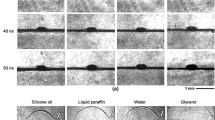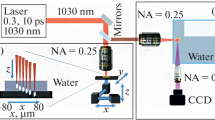Abstract
We investigate shock waves generated by excimer laser ablation of sheet polyimide confined in water. The velocities of the ablation-induced pressure waves in the water are determined by an optical probe system. We measure supersonic velocities up to a few hundred microns away from the irradiated surface, indicating the formation of shock waves. We use these velocities to calculate the corresponding pressures. They are already in the kbar range at fluences comparable to the threshold of ablation. The shock pressure varies as the square root of the incident laser fluence, a behavior that is explained by the rapid heating of the confined gaseous products of ablation.
The initially planar shock waves propagate, become spherical, and decay within a few hundred microns in the surrounding water to acoustic waves. During spherical expansion the shock pressure drops as the inverse of the square of the propagation distance.
The shock waves generated may be relevant in explaining photoacoustic damage observed in biological tissue after excimer-ablation at corresponding irradiances. They may also be important in material processing applications of excimer laser ablation of polymers as they can lead to plastic deformation.
Similar content being viewed by others
References
S. Watanabe, T. Flotte, D. McAucliffe, S. Jacques: J. Invest. Dermatol. 90, 761 (1988)
J. Marshall, S. Trokel, S. Rothery, H. Schubert: Ophthalmol. 92, 749 (1985)
E. Dehm, C. Puliafito, C. Adler, R. Steinert: Arch. Ophthalmol. 104, 1364 (1986)
Y. Yashima, D. McAucliffe, S. Jacques, T. Flotte: Lasers Surg. Med. 11, 62 (1991)
P. Harris, H. Presles: J. Chem. Phys. 77, 5157 (1982)
F. Cross, R. Al-Dhahir, P. Dyer: J. Appl. Phys. 64, 2194 (1988)
P. Dyer, R. Srinivasan: Appl. Phys. Lett. 48, 445 (1986)
H. Philipp, H. Cole, Y. Liu, T. Sitnik: Appl. Phys. Lett. 48, 192 (1986)
J. Brannon, J. Lankard, A. Baise, F. Burns, J. Kaufmann: J. Appl. Phys. 58, 2036 (1985)
C. Puliafito, R. Steinert, T. Deutsch, F. Hillenkamp, E. Dehm, C. Adler: Ophthalmol. 92, 741 (1985)
R. Taylor, D. Singleton, G. Paraskevopoulos: Appl. Phys. Lett. 50, 1779 (1987)
The risetime of our laser pulses is 4 ns. They show an equally fast initial fall that is followed by a pedestal. The intensity is larger than 10% of the peak during a time τ=20 ns that is taken as the pulse duration
P. Teng, N. Nishioka, R. Anderson, T. Deutsch: IEEE J. QE-23, 1845 (1987)
A.G. Doukas, A.D. Zweig, J.K. Frisoli, R. Birngruber, T.F. Deutsch: Appl. Phys. B (in press)
P. Harris, H. Presles: J. Chem. Phys. 74, 6864 (1981)
R. Srinivasan, K. Casey, B. Braren, M. Yeh: J. Appl. Phys. 67, 1604 (1990)
P. Dyer, J. Sidhu: Appl. Phys. 57, 1420 (1985)
T.F. Deutsch, M. Geis: J. Appl. Phys. 54, 7201 (1983)
J. Andrew, P. Dyer, D. Forster, P. Key: Appl. Phys. Lett. 43, 717 (1983)
R. Griffin, B. Justus, A. Campillo, L. Goldberg: J. Appl. Phys. 59, 1968 (1986)
R. Fabbro, J. Fournier, P. Ballard, D. Devaux, J. Virmont: J. Appl. Phys. 68, 775 (1990)
The adiabatic sound speed of polyimide was calculated from PV T-data supplied by the manufacturer. Note that this calculated value, c 0=2165m/s, is but a first approximation, as sheet polyimide is not an isotropic material
D. Blackstock: In: American Institute of Physics Handbook, ed. by D. Gray (American Institute of Physics, McGraw-Hill, New York 1982) pp. 3–190
G. Herzberg: Molecular spectra and molecular structure II. Infrared and Raman spectra of polyatomic molecules (van Nostrand, Princeton, NJ 1968) pp. 501–519
R. Srinivasan, B. Braren, R. Dreyfus: J. Appl. Phys. 61, 372 (1987)
J. Yeh: J. Vac. Sci. A 4, 653 (1986)
S. Lazare, V. Granier: J. Appl. Phys. 63, 2110 (1988)
S. Küper, J. Brannon: In: Technical Digest, Conference on Lasers and Electro-Optics, Paper CFF2 (Optical Society of America, Washington D.C. 1991) pp. 506–508
B. Nikolaus: In: Technical Digest, Conference on Lasers and Electro-Optics, pages Paper TUJ2, (Optical Society of America, San Francisco, SA 1986) pp. 88–89




